

Imagine a workplace where everyone is engaged and the culture thrives. Decisions are made efficiently, and crises are handled with ease.
This is the power of effective internal communications.
Having an effective internal communication strategy is the difference between your organization thriving and sinking when faced with challenges. Yet 60% of companies don’t have a long-term internal communications strategy sorted.
In this article, we’ll cover the basics of what a great internal communications strategy looks like, and how you can achieve that in your company despite being time-poor and on a budget.
You might feel like your back is on the wall, working against the clock to cobble together a presentation or email at the 11th hour to share the next company update.
In these moments, it’s easy to let doubt creep in and wonder if it’s helpful at all or whether your content is being read.
Far from it. Your role is much more than simply passing a message along to the rest of the company. In fact, internal communicators have the ability to shape organizational culture, improving productivity and morale while creating a comms bridge between executives and workers on the ground level.
Finding the right message with the right visual can be a challenge. That’s why we’ve developed a new comprehensive suite of internal communications templates to make your content creation journey easier.
In the meantime, let’s explore these dynamics while also discussing IC’s pivotal role in decision-making processes and crisis communications within an organization.
Effective internal communications isn’t just about keeping employees informed; it’s a crucial tool for boosting engagement and fostering a sense of belonging within the organization.
A recent RingCentral survey showed that 71% of employees who felt more connected also felt more productive.

When you communicate effectively, you’re not just sending messages—you’re inviting dialogue. It creates an environment where every member feels seen, heard, and significant to the team’s success.
The way information flows within your company has a strong influence in several ways on its organizational culture.
Clear and concise messaging creates an open forum where everyone can freely share ideas, from the intern to the CEO. When well-informed, employees are more likely to contribute valuable insights that could positively impact critical decisions.
Also, effective internal communications lead to a speedy resolution of issues as information isn’t trapped in silos but flows freely across all levels.
With great communication, you’re not just leading a team—you’re steering your entire company towards long-term success.
Your company’s ability to share and process information swiftly could mean the difference between chaos and coordinated action.
Effective internal communications before and during a crisis means everyone understands their roles and responsibilities. It promotes unity among teams and avoids duplication of efforts. It also facilitates rapid dissemination of important updates, keeping all staff informed and reducing panic and confusion.
Additionally, it reinforces trust within the organization and helps maintain morale in challenging times. Strong internal communications strengthen bonds as you weather the storm together.
Instead of just broadcasting a message to employees from the C-suite, effective internal communications can play a significant role in employee performance.
Effective communication fosters a culture of accountability, encouraging employees to take ownership of their tasks and roles.


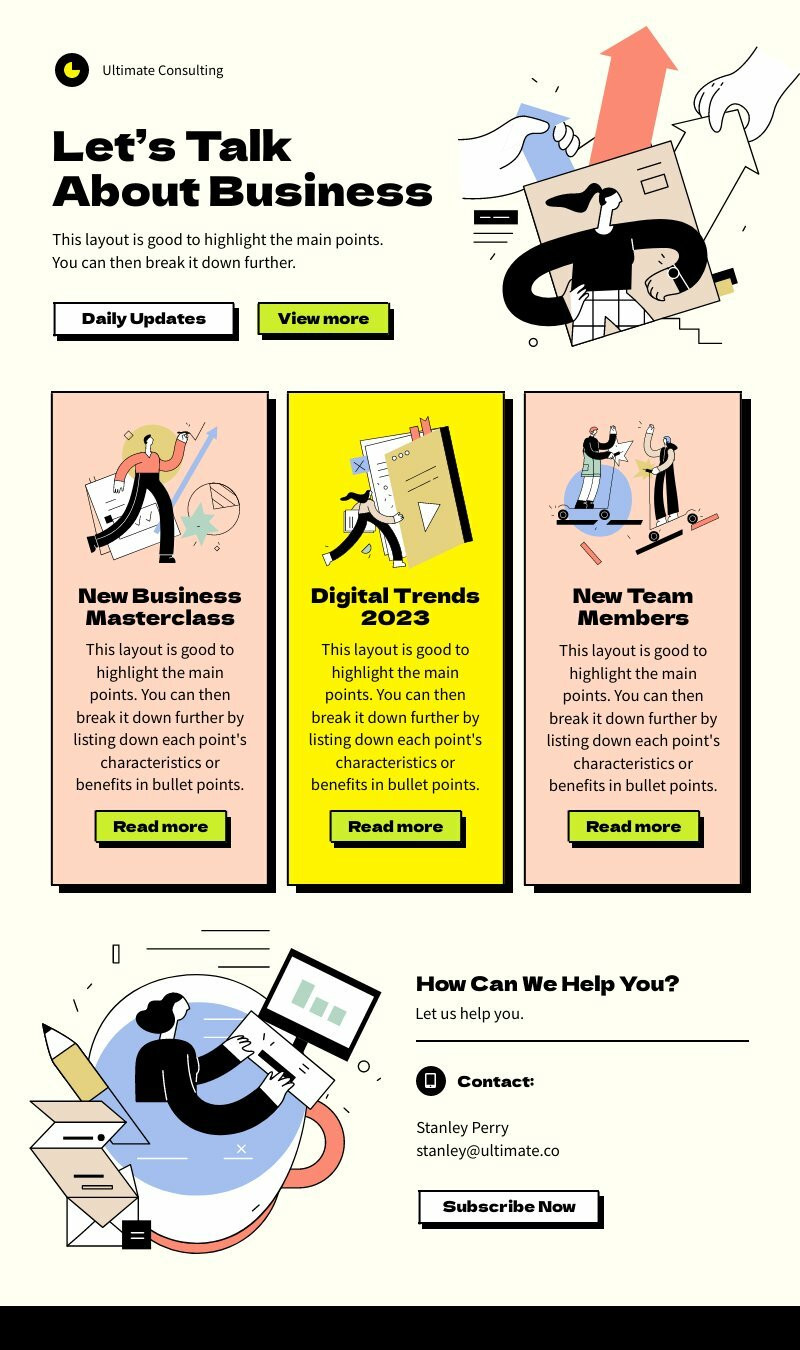
The trouble with one-way communication is that only one side hears a message. If you’re on the sending side, you don’t know how it’s being received or if it’s being acknowledged at all.
Instead, you can use internal communications to build an agile workforce that swiftly adapts to challenges and pivots when needed.

72% of business leaders reported increased productivity among their workforce as a result of improved communications.
From informing employees about the latest policy changes to celebrating work anniversaries, your comms updates help everyone stay connected.
Building this company-wide rapport is important, especially when managing remote working employees.
Employee communications that not only touch on the state of the company but also acknowledge employees’ feedback and contributions can bolster unity and improve morale.
Only 38% of employees understand what their contributions are to the organization’s strategy.

Imagine the rise in productivity and mood if more employees knew how their work was making a difference.
Consider what types of information and the timing of what you share as part of your internal comms strategy.
Internal communications are not a one-size-fits-all affair. Different types of communication serve various purposes and audiences within your organization.
Understanding these types can help you tailor your messaging strategies for maximum impact.
Top-down communication flows from the leadership team to lower-ranking employees. This includes corporate announcements, policy changes, or quarterly goals. For example, the CEO sending out a company-wide email about a strategic shift is a form of top-down communication.
This kind of communication is essential for setting the overall direction and tone for the organization.
Bottom-up communication originates from junior staff and flows upwards. Employee surveys, suggestion boxes, and team meetings where feedback is actively sought are all platforms for this kind of communication. For instance, if a support staff member identifies and communicates a recurring customer complaint to higher-ups, that’s a valuable form of bottom-up communication.
This type refers to the communication that occurs among peers or departments at the same hierarchical level within an organization. Team meetings, inter-departmental collaborations, and even water-cooler conversations fall under this category.
If the marketing team collaborates with the sales team to align their strategies for a product launch, that’s horizontal communication in action.
Imagine a scenario where an IT manager directly communicates with a Marketing Executive about a technical glitch affecting a marketing campaign. This cross-functional, cross-level communication is termed as diagonal communication. It can speed up decision-making processes and problem-solving by cutting through the usual hierarchical paths.
New hire communication focuses on onboarding and integrating new employees into the organization. This starts from the moment an offer is accepted and continues through orientation, training, and the initial months of employment. It includes welcome emails, orientation schedules, training plans, and regular check-ins to gauge how well the new hire is adjusting.
This communication is pivotal for setting the tone of the company culture and ensuring that new hires feel welcomed, valued, and equipped to perform their roles effectively.
For anyone involved in internal communications, incorporating structured new hire communications helps quicker assimilation of the employee and positively impacts employee retention rates and overall job satisfaction.
Wellness communication is an increasingly vital part of any internal communications strategy aimed at promoting employees’ physical and mental well-being. This involves targeted messaging around health and wellness programs, mental health resources, and work-life balance tips.
These communications take various forms, including newsletters, webinars, or simple reminders to take breaks.
Incorporating wellness communication not only reflects organizational care and responsibility but also boosts overall workforce effectiveness. For businesses aiming for long-term success, making wellness communication a fixture in their strategy is not just advisable—it’s essential.
Crisis communications is a specialized type of internal messaging to manage and mitigate emergencies or unforeseen situations. This could range from dealing with data breaches to handling product recalls or even navigating through global pandemics.
The key here is timelines, transparency, and a clear line of command. These communications are generally top-down but should be designed to encourage feedback for rapid response and resolution. Visualize timelines and schedules for effective communication during crises.
Health and safety messaging informs and educates employees about protocols, guidelines, and best practices to ensure a safe and healthy work environment.
Swift and clear communication is essential, whether it’s circulating information about emergency exit routes, detailing steps to take during severe weather conditions, or educating the workforce on new health guidelines.
Diversity communication promotes an inclusive culture, celebrates differences, and addresses issues related to gender, race, ethnicity, sexual orientation, and other dimensions of diversity.
This might include announcements about diversity training programs, updates on company-wide inclusion initiatives, or sharing stories that highlight diverse voices within the organization.
Effective diversity communication creates a sense of belonging for all employees, encouraging them to bring their authentic selves to work. It also makes your company more appealing to a broader range of talent and clientele.
Campaign communication focuses on promoting specific initiatives or objectives within the organization. Whether it’s rolling out a new product, advocating for a cultural shift like sustainability, or driving employee participation in a company-wide survey, campaign communication provides the organization with an update on major campaigns and provides an opportunity to send out a call-to-action where necessary.
Given that campaigns are time-sensitive and results-oriented, they require everyone to pull in the same direction for a limited period. That’s why concise but compelling internal communication is vital for rallying the troops and keeping everyone aligned on the objectives at hand.
A multi-channel approach is usually most effective, utilizing emails, internal social media, and even face-to-face meetings to get the message across.

Selecting the right tools and techniques for internal communications is like laying down the electrical wiring for a building—you want a system that’s both reliable and capable of handling your future needs. Also, consider the ability to personalize your messaging is an important feature.
As you evaluate your options, think about the unique communication needs of your organization. It’s a mix-and-match approach, combining various tools and techniques to create a tailored communication ecosystem that enables your team to excel.
Piktochart is a tool for visual communication meant for your business communication needs. It offers professionally designed templates for presentations, reports, email signatures, and more. Get started today.
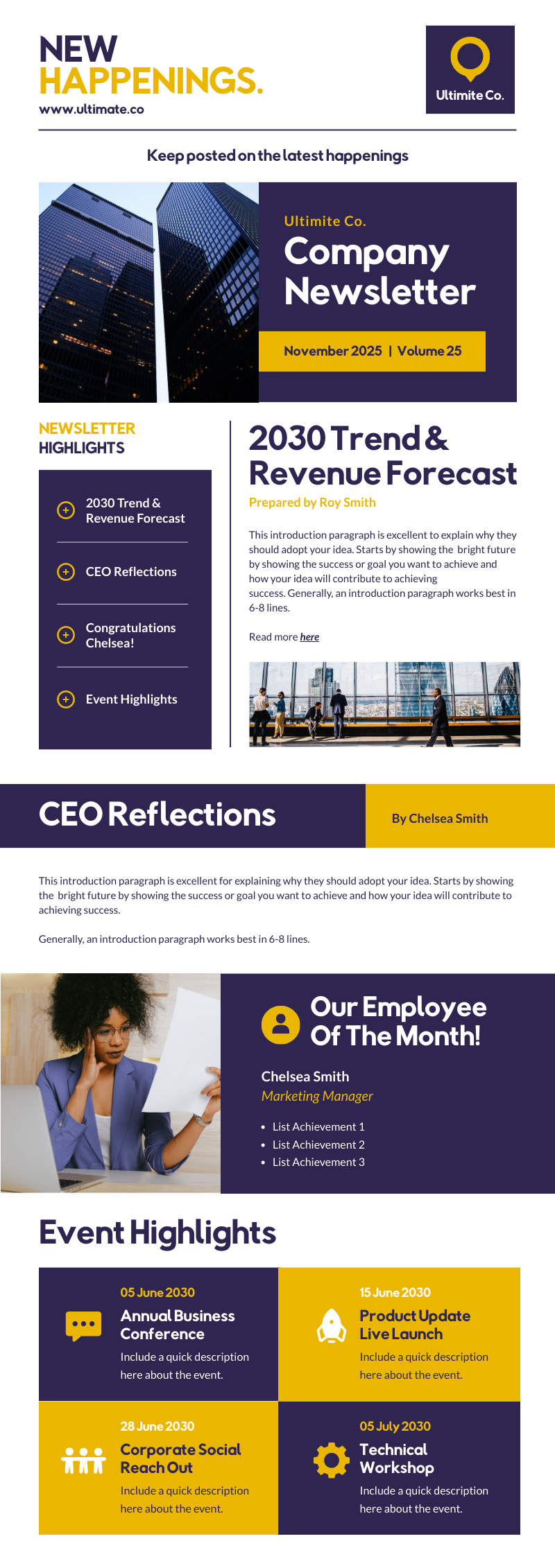
Choosing the right platforms for internal communications is crucial as they’ll influence how effectively your messages reach all employees.
Collaboration tools like Asana or Monday streamline the flow of information and make team projects a breeze.
With an easy-to-use platform that keeps everyone in the loop, you’ll notice fewer misunderstandings and increased efficiency.
Email is still one of the primary communication channels that companies use.
But are you using this channel efficiently?
Sending too many emails can lead to clutter, making it hard for employees to find or recall important information.
Here are some tips to increase the chance of your emails not being sent to spam or ignored:
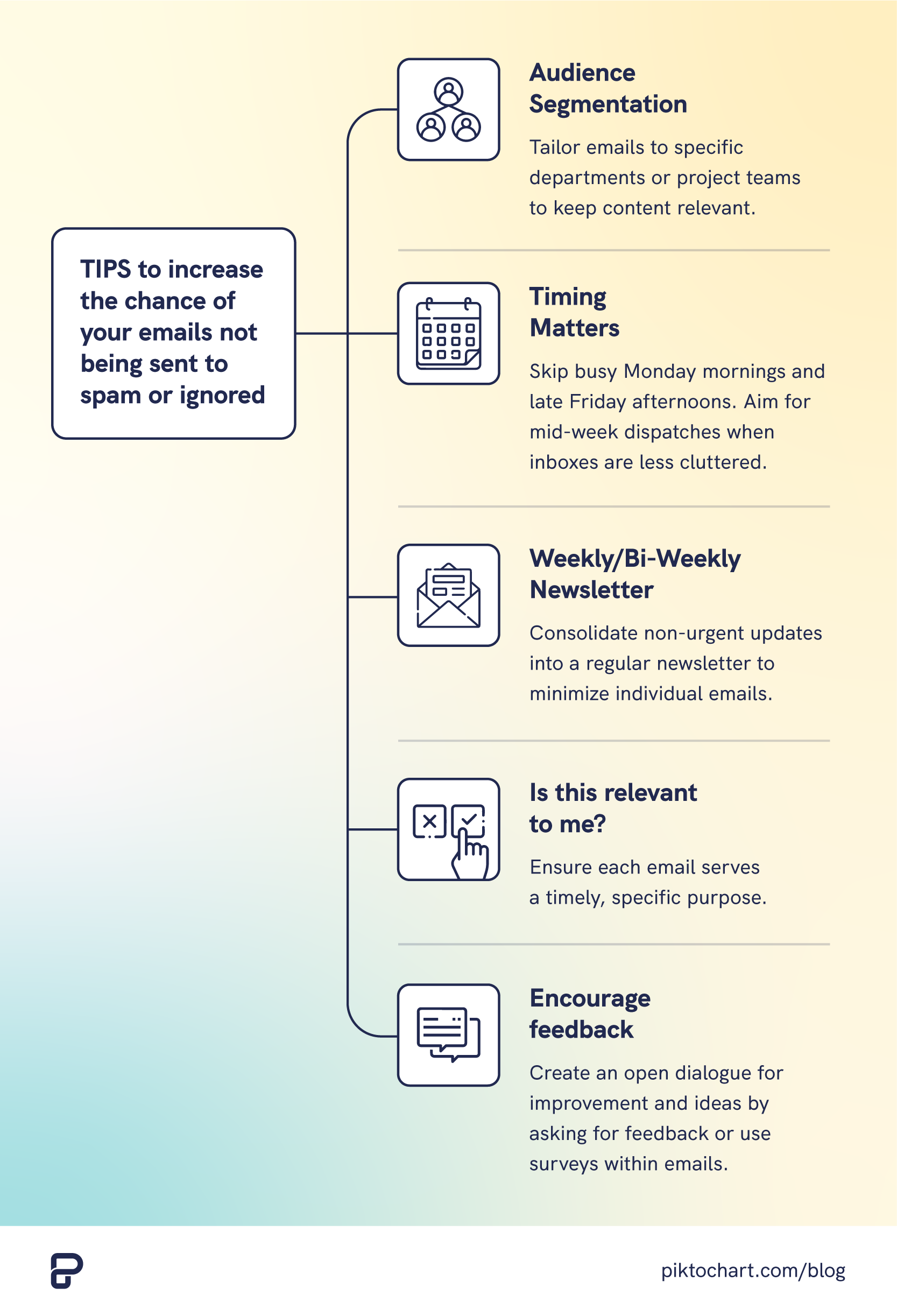
It’s not enough to send information one way; communication is a two-way street.
Being open to feedback is important because it allows for immediate corrections or adjustments to be made. Moreover, feedback systems are crucial in understanding employees’ perspectives.
When your team feels heard and valued:
Navigating the labyrinth of internal communications is no easy feat. It’s like assembling a puzzle, but you’re not always sure if you have all the pieces.
Are your employees bogged down by technological snafus or is the office layout stifling open dialogue?
Is your remote team feeling isolated?
The effectiveness of your internal communications strategy hinges on recognizing and overcoming different types of barriers.
Ever wondered why that groundbreaking project didn’t receive the unanimous support you anticipated?
The bottleneck isn’t usually the idea but barriers in internal communications.
Whether it’s the archaic internet that disrupts virtual meetings or an intimidating office hierarchy that muffles junior voices, understanding these barriers is the first step to dismantling them.
Sadly, employees are becoming increasingly disengaged year on year, according to Gallup. Yet the research all points to better retention and engagement when communication improves.
It all starts with making incremental changes.
But before you can do that, you need to take stock of how engaged your employees are through surveys.
Once you’ve collected enough feedback, you can amend your current internal communications strategy that aligns with the responses.
Managing remote work communication has become a crucial aspect in today’s working world, where more companies accommodate flexible working setups.
It’s not just about ensuring everyone receives the necessary information but also about fostering a healthy and inclusive virtual workspace.
In your quest for effective internal communications, you’ll need to grasp the importance of assessing communication tools, collecting employee feedback, and analyzing communication outcomes.
Employee feedback is not just a gauge of understanding; it’s an invaluable resource that can propel your strategies forward.
Choosing the right communication tool isn’t just about ticking boxes; it’s about finding a solution that integrates seamlessly into your existing workflow while elevating your internal communications.
Here’s a deeper dive into what you should consider:
Part art, part science, collecting employee feedback is a continuous cycle that influences the quality of internal communications and involves blending human interaction with data analysis.
Here’s what to consider when setting up your feedback collection mechanism:
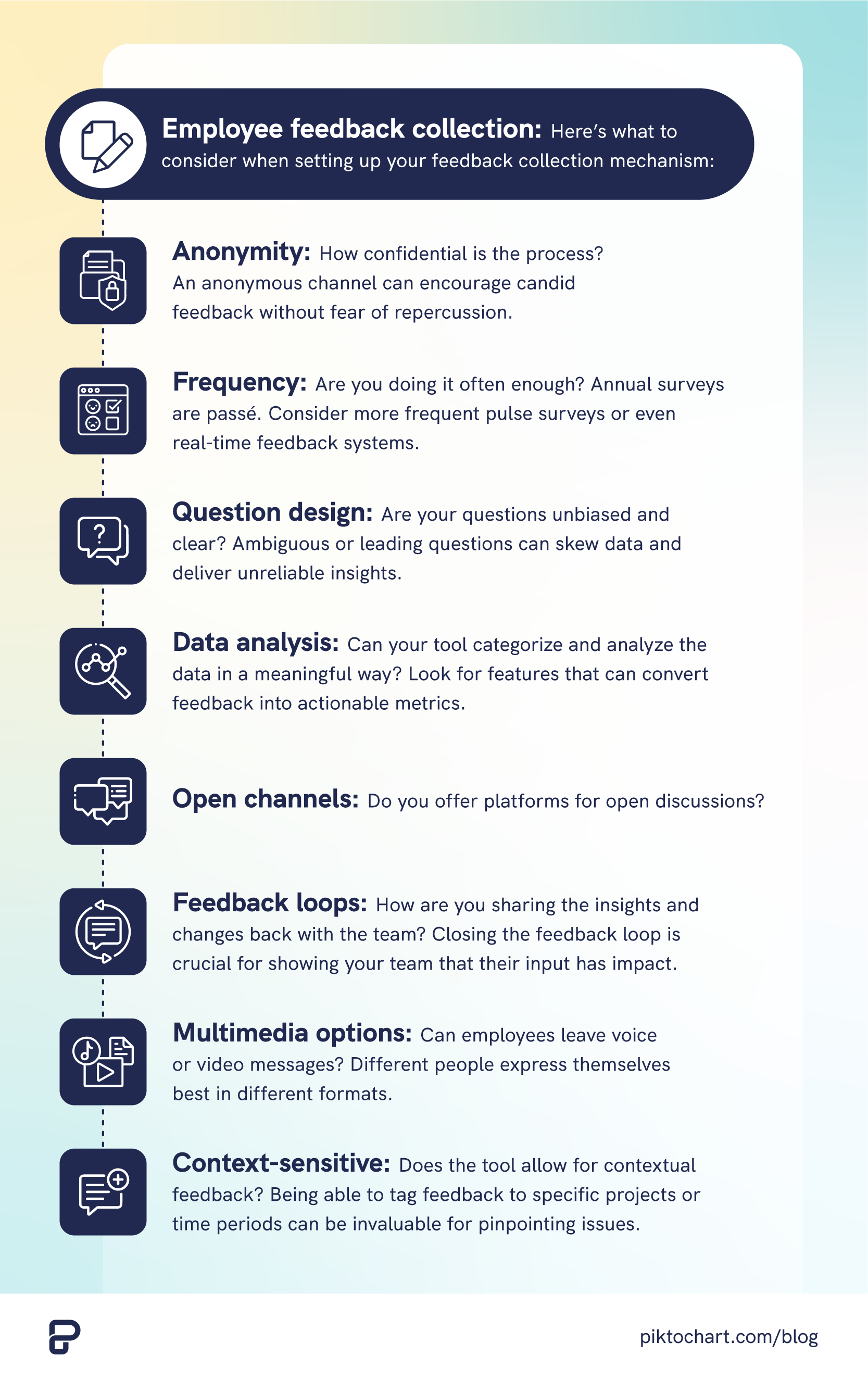
By taking a holistic, analytical approach to feedback collection, you’re not merely gathering data; you’re creating a dialogue that fuels continuous improvement and nurtures a culture of open communication.
Analyzing the outcomes of your internal communications campaigns should be part of any company’s strategy.
Elevating your internal comms isn’t just about sending messages; it’s about understanding their impact.
Consider using quizzes or knowledge assessments to understand how well your employees have grasped critical information rather than relying on feedback surveys.
Even if employees are engaging with the material, look beyond surface-level metrics and check if they’re actively participating in discussions on your intranet platforms or just lurking. This can be a sign of how effective your communication tools really are.
While they may not be direct communication metrics, turnover and retention rates can offer additional insight into the state of your internal comms. Any abrupt changes here might point to deeper issues that need addressing.
By dissecting your communication efforts in this detailed manner, you’re not only fixing problems but identifying opportunities for genuine improvement.
Without an effective strategy, your internal communications efforts will fizzle out and don’t help your business goals at all.
While internal communications looks different for every company, here are some best practices that can increase the likelihood of engaging employees.
Your choice of communication channels can significantly impact message reception and overall workplace engagement. This isn’t just about picking a tool and saying, “Go!”
It involves several key steps:
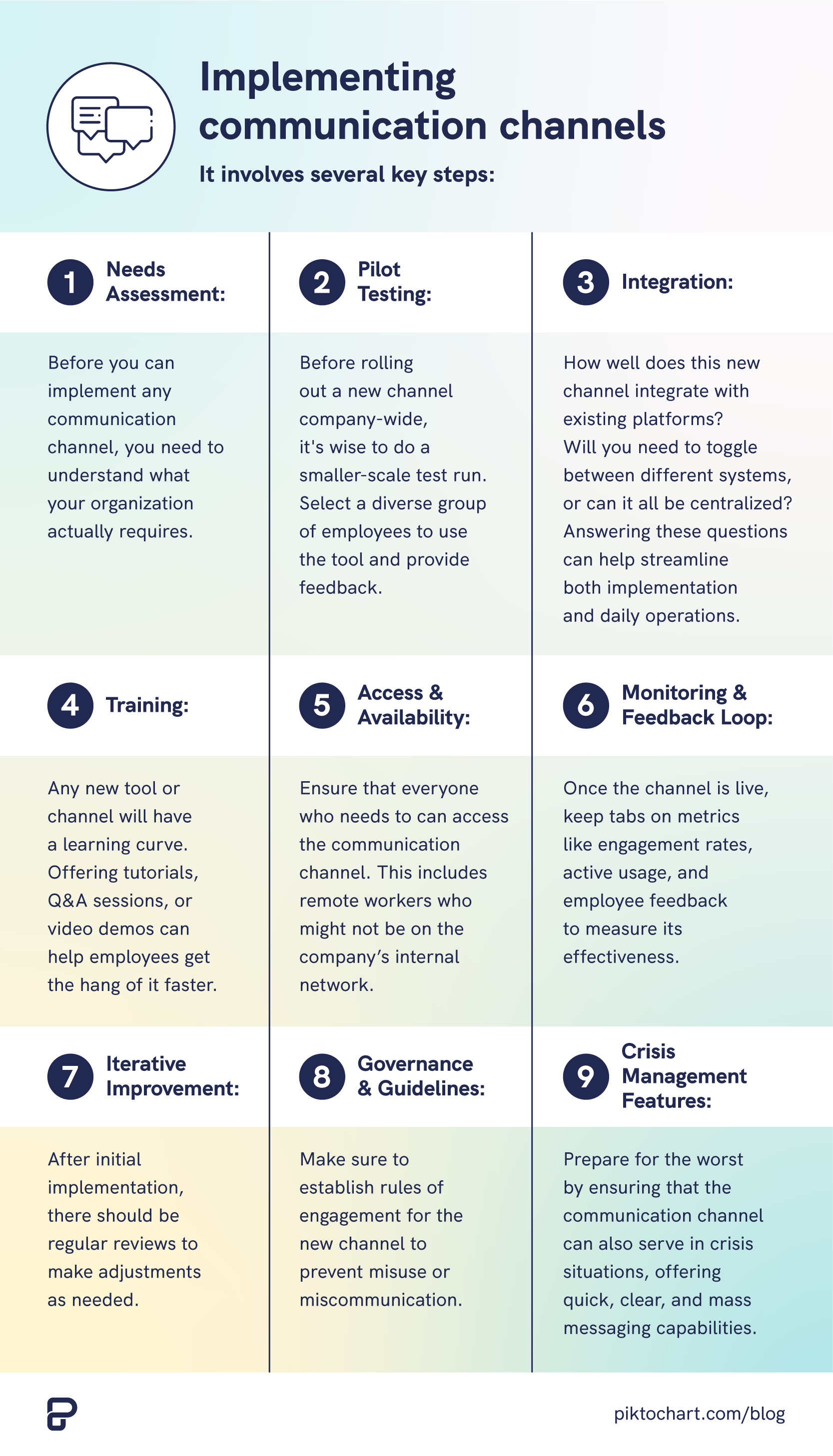
Incorporating feedback and recognition isn’t just an HR best practice; it’s a communication cornerstone.
They serve as critical components of an internal communication strategy, making internal communication important for the well-being of your organization.
Timely, personalized praise and constructive feedback can dramatically boost employee engagement.
When employees feel their contribution is valued, they’re more likely to be motivated and committed to their roles. Regularly providing constructive feedback paves the way for personal growth and professional development, while recognition boosts morale and fosters loyalty.
Transparency is key: Make criteria and expectations clear so that feedback becomes an avenue for growth.
And don’t limit this to a top-down approach. Peer-to-peer recognition and feedback loops enrich the whole communication ecosystem, creating a culture where everyone feels valued and heard.
This goes beyond boosting morale; it aligns everyone with the company’s broader objectives.
During volatile times, the rumor mill can run rampant, causing confusion and eroding trust.
A sound crisis plan keeps everyone from the C-suite to interns aligned and informed, minimizing harm and maximizing coordinated response.
As a part of the internal communications team, your role is pivotal in ensuring smooth and effective communication during crises.
Ensuring consistency in message delivery across different platforms and departments is crucial to avoid any confusion or misinterpretation. As you strive to serve others, remember that a clear, consistent message underpins effective internal communication. This isn’t merely about repetition—it’s about creating a unified voice that resonates with everyone involved.
So why is internal communication important? It fosters trust and transparency, enabling teams to work towards shared communication goals. Consistent messaging ensures everyone understands their roles and responsibilities while aligning them with the company’s values and mission. Inconsistencies can lead to misguidance or misinformation, which hampers productivity.
Internal comms is not just about sharing information; it’s a game-changer that can boost your organization’s performance, engage employees, and promote your brand.
Remember, successful internal communications isn’t an overnight achievement. It takes strategic planning, effective tools, and continual assessment to stay on top of trends and overcome challenges.
Common mistakes you might make in your internal communications strategy include not listening to staff feedback, failing to adapt to new technologies, and neglecting the importance of clear, concise messaging.
Absolutely, good internal communications can enhance your company’s customer service. When you’re all on the same page, everyone understands the customer better and can deliver consistent, high-quality service that truly satisfies.
Internal communication boosts your company’s competitiveness by fostering team collaboration, enhancing productivity, and promoting a unified vision. It ensures everyone understands the strategy, making your business agile and responsive to market changes.
Collaborative and intuitive, creating visuals is easy with Piktochart. Try now for free!